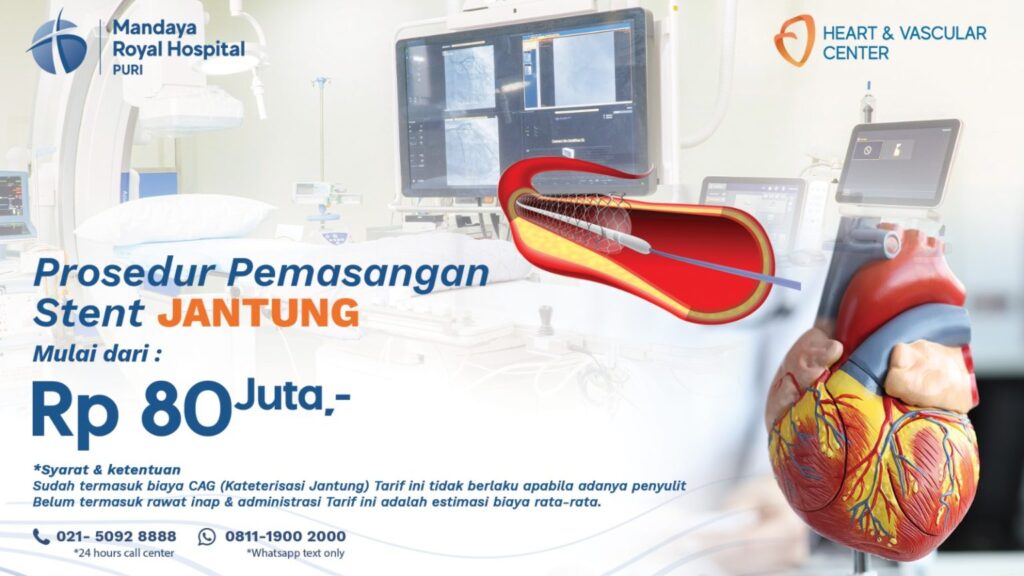When plaque builds up in the coronary arteries, these vessels can become narrowed. This narrowing reduces blood flow to the heart, causing symptoms like chest pain. If a blood clot forms in the narrowed area and fully blocks the artery, it can result in a heart attack.
A heart stent, also known as a coronary stent, is a small, mesh-like tube placed in the artery to keep it open and improve blood flow to the heart.
Contents
Types of Heart Stents
There are several types of stents used to open narrowed coronary arteries:
- Bare-metal stent (BMS): A simple wire mesh tube made of metal.
- Biodegradable stent: A temporary stent that dissolves or breaks down in the body after a few months.
- Drug-eluting stent (DES): A stent coated with medication that is slowly released into the artery to prevent it from narrowing again.
Purpose of Heart Stent Placement
Heart stents are typically needed when a coronary artery is blocked by 70% or more. This blockage can restrict blood flow and lead to symptoms such as chest pain or shortness of breath.
In such cases, the goal of stent placement is to keep the artery open, restore proper blood flow to the heart, and reduce symptoms. Most stents are permanent and are designed to remain inside the artery long-term. By keeping the arteries open, stents can significantly reduce the risk of future heart attacks.
Therefore, stent placement is often a crucial part of treating coronary artery disease.
The Heart Stent Procedure
The procedure to place a stent is a non-surgical intervention called percutaneous coronary intervention (PCI) or angioplasty. It is performed to open up narrowed coronary arteries due to plaque buildup.
Here’s what to expect during and after the procedure:
During the Procedure
- Catheter insertion: A thin, flexible tube (catheter) is inserted into a blood vessel and guided to the heart.
- Balloon inflation: The catheter has a small balloon at the tip that is inflated to open the narrowed artery.
- Stent placement: Once the artery is open, the stent is placed at the site to keep the artery permanently open.
After the Procedure
- Blood-thinning medication: After the procedure, you will likely be prescribed blood thinners such as aspirin, clopidogrel, dipyridamole, or ticlopidine. These medications help prevent blood clots from forming inside the stent. You may need to take them for a year or longer.
- Monitor for complications: The risk of blood clots after the procedure is generally low, unless blood-thinning medication is discontinued. Recurring chest pain may indicate restenosis, where the artery narrows again due to tissue growth. In such cases, another procedure—such as placing a drug-eluting stent—may be necessary.
- Recovery period: Recovery time varies from person to person, but most people need a few days to a week before resuming work or physical activity. Always consult your doctor regarding your readiness to return to daily routines.
- Follow-up care: You may need further check-ups with a cardiologist or pulmonologist, depending on your overall health condition. It is essential to follow your doctor’s instructions and attend regular check-ups to ensure the best results and minimize complications.
Heart Stent Placement at Mandaya Royal Puri Heart Center

Mandaya Royal Puri Hospital is equipped with a state-of-the-art Heart Center that offers heart stent procedures performed by experienced cardiologists.
The Heart Center is also supported by advanced technologies for various heart conditions, including PFA cardiac ablation for treating atrial fibrillation (AFib).
Other heart treatments available at Mandaya Royal Puri include:
- Coronary Artery Bypass Grafting (CABG)
- Pacemaker implantation
- 2D and 3D cardiac ablation
- Heart valve repair and replacement
For your convenience, book an appointment through WhatsApp, Book Appointment, or the Care Dokter app, available on Google Play and the App Store. These tools allow you to check your queue number and access complete information for your visit.



